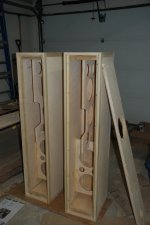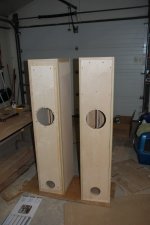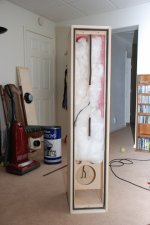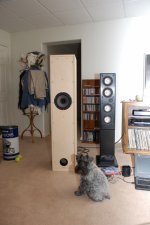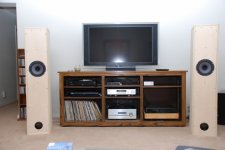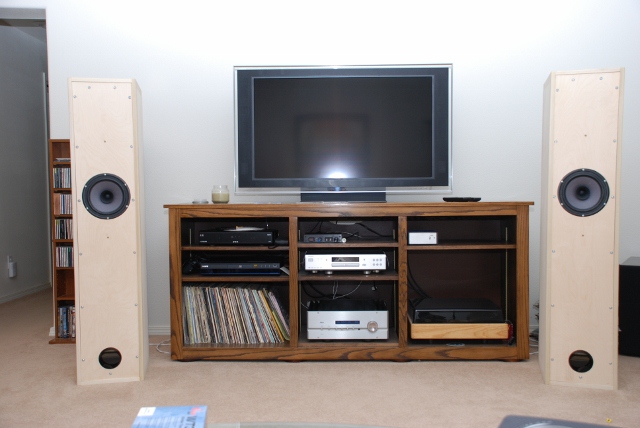I have built a SEAS FA22RCZ MLTL using Scott Moose dimensions as detailed in Seas FA22RCZ full range prosject. They are as follows internal dimensions 56in by 10.5in by 14in (HxWxD) Zd=21.125in Zvent 54in vent 4 in by 3.5 in. Design requirements: 1. Make the front panel removable so that if I don't like the results I can use the enclosure for another project. 2. Design enclosure to Scott Moose dimensions to obtain a Mass Loaded Transmission Line. 3. Use Baltic Birtch plywood for enclosure and use lining and stuffing per accepted full range designs. 4. Compare MLTL full range to my other speakers. Will post pictures of build and final results.
It's just the picture, the shelving filter is 1.5mh in parallel with 8 ohms. In the current configuration this is not a high sensitivity speaker it is around 88 db (estimate) efficient. Since the pictures were taken I have removed some of the stuffing which brought back a little more life to the over all sound without affecting the bass. the bass response is very good for a 8in single speaker, I can turn off my sub and not miss it at all. This speaker can play loud but does start to compress the sound at higher levels i.e. it is not as linear to power input from around 85db on up as it is to lower levels. I would assume this is to be expected from a single 8 in. speaker. The drivers must be close to published specs from Seas as the impedance plots were right on per simulated response using Jeff Bagley(sp) spead sheets, I do have wt3 impedance plots if any one is interested I can attempt to post them. These speakers require a fair amount of break in so give them a couple of weeks, I broke them in using a cardboard box playing them for 4 days stright in the garage at various levels before putting them into the MLTL. More on the overall sound later.
Thanks for sharing, This is a project that caught my eye and looked very interesting. I'd be temped to remove the cavity stuffing and just line all the walls! If there are any nasty cavity air resonances they will show up on your WT3 impedance plot as spikes! In my experience it's easy to over stuff, and this can affect the mid bass and mid range sounding dull!
My two cents.
My two cents.
The mass loaded transmission line that the enclosure was built to was from Scoot Moose who I assume derived the dimensions from Martin King quater wave math cad worksheets. BTW thanks Scott for the layout as it seems to be dead on. If you want to build a vented enclosure then I suggest using Jeff Bagby woofer box and circuit designer which runs on Excell Google and then download it's free and a good program. As an example using Bagby for a vented enclosure of dimensions 40in by 10in by 14in (HxWxD outside dimensions) with a vent of 4in dia. by 6.98in long will give you the follwing:
Fd 38.68Hz 3db point 39.92 hz the same enclosure sealed will you a Fc 52.49hz with a Qtc of 0.612 and a 3db of 62.75hz.
Fd 38.68Hz 3db point 39.92 hz the same enclosure sealed will you a Fc 52.49hz with a Qtc of 0.612 and a 3db of 62.75hz.
Last edited:
Enclosure comments as built, this is the most braced enclosure I have ever built, it is also the most resonate enclosure I have ever built. In the past I have used MDF and various plywood and have lined them with acoustic foam or sonic barrier which have resulted in very dead sounding panels via rap test and music. This is not the case with this enclosure which sounds very live with both rap test and with music. I don't think the Baltic Birch ply has any thing do with the results. This is also the largest speaker cabinet I have built. The panels appear to resonate in the mid range which is good for the bass reponse as it is above bass fequencies, but I'm not so sure about the midrange. If I was building a vented enclosure I would use the above foam or sonic barrier to deaden the panels. The front panel of my enclosure is made up of the 3/4 birch with 1/2 birch glued to it to give a thickness of 11/4 in. and it is less resonate so maybe the thing to do is to double the thickness of all the panels.
Compression above 85db
"Since the pictures were taken I have removed some of the stuffing which brought back a little more life to the over all sound without affecting the bass. the bass response is very good for a 8in single speaker, I can turn off my sub and not miss it at all. This speaker can play loud but does start to compress the sound at higher levels i.e. it is not as linear to power input from around 85db on up as it is to lower levels. I would assume this is to be expected from a single 8 in. speaker. "
The speakers are not likely compressing the sound at anywhere near 85db in the listening room. While the loudspeakers sensitivity has been decreased by a frequency dependent voltage divider (to compensate for a rising HF), the sensitivity of the driver itself is unchanged. The amount of power the voice coil is seeing while producing 85db in the listening room is at most only a few watts (RMS). While SEAS has not released data on compression for this driver, this is well below power levels where audible compression would be expected. Most likely the 'compression' you are hearing is due to the enclosure being overstuffed. The improvement in sound quality ("a little more life") you heard after removing some of the stuffing is indicative of this. To arrive at the optimum stuffing I would follow the suggestion made by larryldspkr: "remove the cavity stuffing and just line all the walls", listen, then add stuffing in steps (with listening in between) until you are pleased with the result. You may find that there is a compromise or optimum balance between bass quality and dynamics.
Good luck,
Bob
"Since the pictures were taken I have removed some of the stuffing which brought back a little more life to the over all sound without affecting the bass. the bass response is very good for a 8in single speaker, I can turn off my sub and not miss it at all. This speaker can play loud but does start to compress the sound at higher levels i.e. it is not as linear to power input from around 85db on up as it is to lower levels. I would assume this is to be expected from a single 8 in. speaker. "
The speakers are not likely compressing the sound at anywhere near 85db in the listening room. While the loudspeakers sensitivity has been decreased by a frequency dependent voltage divider (to compensate for a rising HF), the sensitivity of the driver itself is unchanged. The amount of power the voice coil is seeing while producing 85db in the listening room is at most only a few watts (RMS). While SEAS has not released data on compression for this driver, this is well below power levels where audible compression would be expected. Most likely the 'compression' you are hearing is due to the enclosure being overstuffed. The improvement in sound quality ("a little more life") you heard after removing some of the stuffing is indicative of this. To arrive at the optimum stuffing I would follow the suggestion made by larryldspkr: "remove the cavity stuffing and just line all the walls", listen, then add stuffing in steps (with listening in between) until you are pleased with the result. You may find that there is a compromise or optimum balance between bass quality and dynamics.
Good luck,
Bob
Removing the stuffing did not change the apprent loudness for a given amp output at a listing level. The loudness i.e. efficiency with respect to amp output appears to be a function of the shelving filter. What I was pointing out as I mentioned above in this configuration this is not a super effieient speaker so do not try to drive it with low power amps. As I understand the way MLTL works the stuffing is to dampin and smooth the upper response of the standing waves generated via. the quaterwave tuning. If you remove the stuffing or most of it then just build a vented enclosure. At this time the stuffing is around 0.3 pound per cubic foot. Thanks for the comments as all information is usefull.
Last edited:
Least any one thinks I am not pleased with the results of this effort think again. The speakers do some things amazingly well, the bass is very good for a single driver the midrange is exceptional particularly on vocal and instrumental the higher frequencies can get a little harsh depenent upon the music and the venue. And yes they do get a little congested on full blown concert venue. This is all in compaison to very good multi way systems. I can envision a system to live with for a long time comprised of these speakers, a BA2 or F5 amp and a Benchmark Dac or similar DAC. If you have the room for large enclosures then highly reccomended. I know of no other speaker that approach this level of performance at the price of these drivers and the cost of the cabinets (if you build them).
This turned out to be great design with lots of potential, thanks to Jim M for taking the plunge and breaking new ground! I hope to have a pair of these gracing my listening room soon. As far as these becoming just a bass reflex by removing the stuffing, I recall Bob Brines MLTL FT 1600 had best results with all stuffing removed. Reportedly improving the mid-range response and still being a quarter wave resonator. Thanks again for sharing your results Jim.
Larry
Larry
Zd=21.125in Zvent 54in vent 4 in by 3.5 in.
Impressive, really want to make a pair ASAP. But a little unsure what the above refers to.
Would it be possible to put the port on the rear ? Think would look nicer there. Is the plastic port used here a standard size I can buy ?
Also what is the thickness of the internal bracing used ?
Thanks and really looking forward to getting started on these.
The enclosure I built was as follows: Internal dimensions 54 inches tall, 10 inches wide,13.5 inches deep. The wood was baltic birch approx. 3/4 inch. the front panel was made up of 3/4 in and 1/2in for extra strength, all the bracing on the inside was 3/4 baltic birch. The 21.125in dimension (referenced from inside) was from the top, the port I used was a 4 inch port from Parts express. As I said these are large enclosures. If I had it to do over I would just use MDF rather than the Baltic Birch as it was hard to obtain where I live. The key to a MLTL appears to be the stuffing so make it so you can have easy access to the interior to add and remove stuffing. I also question if all the bracing I did was necessary. This speaker is hard to beat for the price.
Best of luck.
Best of luck.
- Status
- This old topic is closed. If you want to reopen this topic, contact a moderator using the "Report Post" button.
- Home
- Loudspeakers
- Full Range
- SEAS FA22RCZ MLTL
